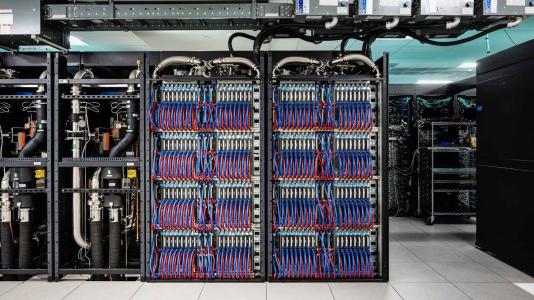Argonne’s new Sunspot testbed provides on-ramp for Aurora exascale supercomputer
Early runs are showing significant performance improvements and faster calculation speeds

Researchers preparing scientific codes and workloads to run on the Aurora exascale supercomputer at the U.S. Department of Energy’s (DOE) Argonne National Laboratory now have a new resource at their disposal.
Named Sunspot, the new test and development system has the exact same architecture as Aurora, which is currently under construction at the Argonne Leadership Computing Facility (ALCF), a DOE Office of Science user facility. It’s an important way for researchers to get a head start on testing the powerful new system before its fully operational.
“Sunspot is basically a miniature version of Aurora,” said Argonne’s Susan Coghlan, ALCF project director for Aurora. “It gives teams a platform to optimize code performance on the actual Aurora hardware.”
“Sunspot is the first time we’re seeing how everything is working together. It gives us a chance to iron out some of the kinks before Aurora is ready for users.” — Susan Coghlin, ALCF project director for Aurora
Prior to Sunspot’s arrival, development teams leveraged earlier Aurora testbeds and other DOE supercomputers, including Argonne’s Polaris, to carry out exascale code development. While those systems continue to be useful tools for Aurora preparations, Sunspot’s identical architecture gives researchers an ideal environment to further optimize application performance for the exascale supercomputer.
“Test and development systems are an important on-ramp for larger production supercomputers,” said Tim Williams, co-manager of the ALCF’s Aurora Early Science Program. “With our Early Science Program for new supercomputers, the goal is to be ready for science on day one of deploying a new system. Testbeds like Sunspot allow researchers to carry out performance studies and scale up their workloads to run on much larger supercomputers while those systems are still being built.”
The Aurora Early Science Program is supporting 15 research teams tasked with preparing key applications for the architecture and scale of the new supercomputer, with a strong emphasis on incorporating data-intensive computing and artificial intelligence applications. In the process, these teams also help solidify software libraries and infrastructure to pave the way for other researchers to run on the system.
Other early users of Aurora are from DOE’s Exascale Computing Project. Launched in 2016, the project is a massive multi-institutional initiative focused on building a capable exascale computing ecosystem. This includes developing the applications, software and hardware technologies that will support science on the nation’s first exascale systems.
Aurora, an Intel-Hewlett Packard Enterprise system, will be comprised of more than 10,000 nodes, each equipped with two new Intel Xeon CPU Max Series processors and six Intel Data Center GPU Max Series processors. Sunspot is a two-rack testbed computer with 128 nodes of the same technologies.
Since Sunspot’s launch in December, over 180 researchers from over 20 application development teams have used the testbed. Williams noted that the early runs on the Intel Max Series GPUs have been promising. Researchers are reporting significant performance improvements and faster calculation speeds.
The ALCF team expects the codes to see further performance improvements as researchers continue to work on Sunspot and other available computing resources. The ALCF is also using the testbed for various Aurora training events, including hackathons and a tutorial at the Exascale Computing Project’s recent 2023 annual meeting.
In addition to helping researchers prepare applications for Aurora, Sunspot is also extremely valuable to the ALCF and Intel as they continue work to stand up the exascale system.
“Sunspot is the first time we’re seeing how everything is working together,” Coghlan said. “We learn a lot from these runs. It gives us a chance to iron out some of the kinks before Aurora is ready for users.”
“Some bugs don’t show up until you start running real applications on the hardware, that’s the whole idea behind the Early Science Program,” Williams added. “These early runs help with uncovering and, in some cases, actually diagnosing issues.”
Sunspot is expected to serve a role even after Aurora is powered on. Like the ALCF’s previous test and development systems, Sunspot can be proving ground for new users to test and optimize code performance before moving to Aurora. ALCF staff can also use it to validate and benchmark new software that is targeted for Aurora.
The Argonne Leadership Computing Facility provides supercomputing capabilities to the scientific and engineering community to advance fundamental discovery and understanding in a broad range of disciplines. Supported by the U.S. Department of Energy’s (DOE’s) Office of Science, Advanced Scientific Computing Research (ASCR) program, the ALCF is one of two DOE Leadership Computing Facilities in the nation dedicated to open science.
Argonne National Laboratory seeks solutions to pressing national problems in science and technology by conducting leading-edge basic and applied research in virtually every scientific discipline. Argonne is managed by UChicago Argonne, LLC for the U.S. Department of Energy’s Office of Science.
The U.S. Department of Energy’s Office of Science is the single largest supporter of basic research in the physical sciences in the United States and is working to address some of the most pressing challenges of our time. For more information, visit https://energy.gov/science.
